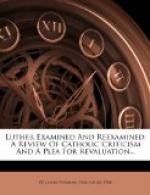Writers belonging to a church that is rich in legends of the saints and in relics ought to know how a tale like Wicel’s can assume respectability and credibility in the course of time. It is not any more difficult to account for these tales about Hans Luther’s homicide than for the existence in our late day of the rope with which Judas hanged himself, or the tears which Peter wept in the night of the betrayal, or the splinters from the cross of the Lord, or the feathers from the wings of the angel Gabriel, and sundry other marvels which are exhibited in Catholic churches for the veneration of the faithful.
No historian that has a reputation as a scholar to lose to-day credits the story of Hans Luther’s homicide. It is improbable on its face. The small landholdings of Hans at Moehra are not real, but irreal estate. Nobody has found the title for them. There is, however, a very good reason why Hans should want to leave Moehra. He was, according to all that is known of his father’s family, the oldest son. According to the old Thuringian law the home place and appurtenances of a peasant freeholder passed to the youngest son. McGiffert regards the custom as “admirably careful of those most needing care.” (p. 4.) Luther’s father, on coming of age, was by this law compelled to go and seek his fortune elsewhere, because opportunity for rising to independence there was none for him at Moehra.
If Hans was a fugitive from justice, he was certainly unwise in not fleeing far enough. For at Eisenach, whither he went, he was still under the same Saxon jurisdiction as at Moehra. He seems to have had no fear of abiding under the sovereignty which he is claimed to have offended. This observation has led one of the most exact and painstaking of modern biographers of Luther, Koestlin, to say that the homicide story, if it rests on any basis of fact, must either refer to a different Luther, or if to Hans, the incident cannot have been a homicide. It should be remembered that there is no authentic record which in any way incriminates Hans Luther.




